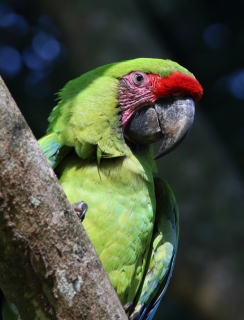Great Green Macaw |
|
|
Also known as: Buffon's Macaw, Green Macaw, Grand Military Macaw, Grand Green Macaw, Guayaquil Green Macaw
Photos
View in GalleryDid You Know?
The Great Green Macaw is one of the heaviest parrots at 1300g (nearly 4lb).Programs & Projects
WPT has worked with numerous partners to help save this species. Learn moreAcademic Research
Related publications: Ara ambiguusSpecies Profile
Genus: Ara | Species: ambiguus
Size:
77-85 cm (30-33 in)
Weight:
1300g (45.5 oz)
Subspecies including nominate:
two: A.a. ambiguus, A.a. guayaquilensis
Colour Adult:
A.a. ambiguus: Both adults yellow/green body colour; forehead and lines on lores red; throat tinged with olive/brown; uppertail orange/red tipped with dull blue. Bill dark grey tipped with pale grey; bare face pink/white with lines of olive/brown feathering. Eye dull yellow.
A.a. guayaquilensis: Both adults as in ambiguus, but with smaller, narrower bill.
Colour Juvenile:
As in adult but duller and with shorter tail tipped with yellow. Eye grey.
Call:
Loud squawks and growls; also creaking or groaning sounds.
Listen NowVideo Links:
Video 1More Information:
Ara Manzanillo
Fundación Jambeli
Fundación Pro-Bosque
Content Sources:
CITES
BirdLife International
Cornell Lab of Ornithology/Birds of the World
A Guide to Parrots of the World, Juniper and Parr, 1998
ML Media Collection Catalogue 25924, Great Green Macaw Ara ambiguus, Parker, Theodore A., III, Darien, Panama, Feb. 13 1982, Cornell Lab of Ornithology. Site
Parrots: Status Survey and Conservation Plan 2000-2004, Synder, McGowan, Gilardi and Grajal, 2000.
Parrots of the World, Forshaw and Cooper, 1989. 2010 edition
Vanished and Vanishing Parrots, Forshaw, 2017.
Parrots of the World, Forshaw, 2006.
Parrots in Aviculture, Low, 1992.
Lexicon of Parrots, Thomas Arndt.
Avian Pediatric Seminar Proceedings, various authors, 1988.
Psittacine Aviculture, Schubot, Clubb and Clubb, 1992.
Photos
View in GalleryDid You Know?
The Great Green Macaw is one of the heaviest parrots at 1300g (nearly 4lb).Programs & Projects
WPT has worked with numerous partners to help save this species. Learn moreAcademic Research
Related publications: Ara ambiguusSpecies Care
Captive Status:
Kept in captive breeding programmes.
Longevity:
60 yrs
Housing:
A large enclosure 15m (50 ft) long in off breeding season - keeping permanently indoors not recommended.
Diet:
Soaked or sprouted sunflower seed, walnuts, peanuts, pecans, Brazil nuts and pine nuts; fresh corn, cooked maize; fruits such as banana, oranges, and nutritionally complete kibble for macaws.
Enrichment:
Large aviary with tree trunk in middle decorated weekly with fresh branches of pine or eucalyptus, large chewable toys made for macaws; also provide overhead misters for bathing.
Nest Box Size:
Barrel, 21in x 36in.
Clutch Size:
3
Incubation Time:
26 days
Fledging Age:
12-13 weeks
Hatch Weight:
23g (0.8 oz)
Peak Weight:
1152g (40.3 oz)
Weaning Weight:
930-985g (32.5-34.5 oz)
Photos
View in GalleryDid You Know?
The Great Green Macaw is one of the heaviest parrots at 1300g (nearly 4lb).Programs & Projects
WPT has worked with numerous partners to help save this species. Learn moreAcademic Research
Related publications: Ara ambiguusSpecies Wild Status
World Population:
500 - 1000 mature individuals
IUCN Red List Status:
Critically Endangered
CITES Listing:
Appendix I
Threat Summary:
This macaw is extremely sensitive to habitat disturbance. Also hunted for food in some areas, and caught for the wild-bird trade.
Range:
A.a. ambiguus: Caribbean lowlands of E Honduras to W Colombia and W Ecuador. E Nicaragua to lowlands of Costa Rica mostly on Caribbean slope. In Panama on Caribbean slope; from E Panama to tropical zone of Colombia and parts of the Andes.
A.a. guayaquilensis: W Ecuador, in north, Esmeraldas, in S Chongon Hills.
Habitat:
Lowland humid forest; also strongly deciduous forest. In Costa Rica lowland primary forest. Reaches 600m (1968 ft) in Costa Rica, 1000m (3280 ft) in Panama.
Wild Diet:
Recorded food items include seeds, including the very hard-shelled Lecythis costaricensis, nuts, fruits, flowers, bulbs, roots and bark. Seeds of almendro (Dipteryx panamensis) a major part of the diet.
Ecology and Behaviour:
Less gregarious than other large macaws; found in pairs and groups of 3-4 birds. Rest and forage in upper areas of canopy where they are less obvious. Will fly long distances to reach feeding areas.
Clutch and Egg Size:
3 elliptical eggs 55 x 45mm (2.1 x 1.7 in).
Breeding Season:
May-October in Ecuador, dry season (December-April) in Costa Rica. Nest is in tree hollow, usually Dipteryx panamensis in Costa Rica.
Related Links:
Photos
View in GalleryDid You Know?
The Great Green Macaw is one of the heaviest parrots at 1300g (nearly 4lb).Programs & Projects
WPT has worked with numerous partners to help save this species. Learn moreAcademic Research
Related publications: Ara ambiguusMembers Only Resources
Please log-in now to find more research, resources and tools.
Not a Member?
Find more great information:
Gain exclusive access to 600+ pages of additional research, seminars and podcasts, specialists to ask your toughest questions, and dozens of other fun resources - when you become a WPT member.
Join Today >>

































